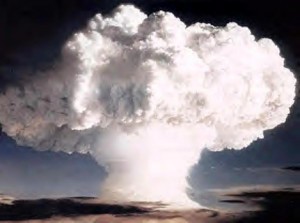Difference between Chemical Weapons and Nuclear Weapons
Chemical Weapons vs Nuclear Weapons
Weapons of Mass Destruction (WMD) are unlike what can be seen in real life. The most potent bombs and guns are dangerous enough, but weapons of mass destruction are in a different league of their own. These are unconventional weapons that can wipe out entire cities and countries through their destructive powers. WMD are of three types – nuclear weapons, biological weapons and chemical weapons. Together these three are known by the military acronym NBC.
While both nuclear and chemical weapons form parts of WMD they are essentially different.
Nuclear weapons
Nuclear weapons are more dangerous than chemical weapons because of the extent of destruction that they can cause. A nuclear weapon can destroy everything in its wake, including lives and structures. Deployment of a nuclear weapon can destroy an entire city and obliterate everything in and around it.
Nuclear weapons are able to create massive explosions through nuclear fission. In this process a nucleus is split and the result is a scale of explosion that the world has seen just twice, thankfully. The effects of nuclear weapons can last for days, months and even centuries.
The words that are associated with nuclear weapons are uranium, plutonium and hydrogen bomb.
Chemical weapons
Chemical weapons can be said to be equally dangerous, although they cannot destroy structures. They are used to destroy lives. Entire communities of people can be killed using chemical warfare.
Chemical weapons contain poisonous chemicals that are deployed using IEDs, mortars and missiles and other agents. These agents cause explosions that result in the poisonous chemical being spread in the air. These chemicals are lethal enough to kill anyone that even gets a whiff. The effects of chemical weapons last till total cleanup of the air is not performed.
The words that are used with chemical weapons are anthrax, sarin gas, chlorine gas and mustard gas.
Who has nuclear and chemical weapons?
In the initial stages only two countries had nuclear weapon stockpiles – The USA and the USSR. The countries that followed the USA and the USSR in developing nuclear weapons were the UK, France and China. Later on India and Pakistan also developed nuclear weapons and this cause massive unrest in the entire global political scenario. India and Pakistan, as the whole world knows, are the bitterest of enemies.
Israel and North Korea are also reportedly owners of nuclear weaponry, but none of these countries have admitted to owning stockpiles of nuclear warfare. During the 80s South Africa also developed nuclear warfare, but it became the first country to publicly destroy all nuclear weapon stockpiles.
Chemical weapons are known as the “poor man’s nuclear weapons” and there are several countries that have developed these weapons. Apart from the largest and the most important countries in the world smaller countries in Asia, Europe and Africa also possess these weapons. India and Germany are two countries that are known to have destroyed all the chemical weaponry.
Uses of nuclear and chemical weapons
There have only been two uses of nuclear weapons. On August 6, 1945 “Little Boy” was dropped on Hiroshima and on August 9, 1945 “Fat Man” was dropped on Nagasaki. The number of deaths caused by these two bombings is expected to be in excess of 200,000. But worse, a number of generations of Japanese suffered due to the long range radiation effects of these two bombs.
Chemical weapons were first used during World War I. France was the first country known to use bombs containing dianisidine chlorosulfonate. During the 80s, Iraq used chemical weapons on Iran. In 1988 Saddam Hussein ordered chemical weapons to be used on the Kurdish people of Halabja. In 1994, Sarin gas was used in the Matsumoto residential community and in the next year it was again used in the Tokyo subway.
Stoppage of use
Various treaties have been signed over the years to stop the use of nuclear and chemical weapons. It started in 1963 with the Partial Test Ban Treaty. Later on the Nuclear Non Proliferation Treaty and the Comprehensive Test Ban Treaty were also signed.
Summary:
-
Both nuclear and chemical weapons and weapons of mass destruction.
-
Nuclear weapons destroy lives and structure through nuclear fission and chemical weapons destroy lives through poisonous chemicals.
-
Nuclear weapons and more destructive than chemical weapons and their effects last longer.
-
Nuclear weapons are owned by a handful of countries, but chemical weapons are owned by many countries.
- Only two instances of nuclear weapon usage are known while chemical weapons have been used many times.
- Difference between Curcumin and Cumin - May 22, 2014
- Difference between Simulated Diamond and Lab-Created Diamond - May 21, 2014
- Difference between Saline Soil and Silty Soil - May 20, 2014
Search DifferenceBetween.net :
1 Comment
Leave a Response
References :
[0]http://cdn2-b.examiner.com/sites/default/files/styles/image_content_width/hash/7f/79/nuclear_blast.jpg?itok=rj_1vMMI


First of all I would like to say Mind blowing stuffs and website!!
The info provided by you worth to keep in mind…